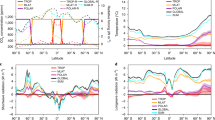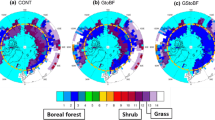Abstract
We examine the effects of non-linear interactions between surface albedo, water vapor and cloud cover (referred to as climate variables) on amplified warming of the polar regions, using a new energy balance model. Our simulations show that the sum of the contributions to surface temperature changes due to any variable considered in isolation is smaller than the temperature changes from coupled feedback simulations. This non-linearity is strongest when all three climate variables are allowed to interact. Surface albedo appears to be the strongest driver of this non-linear behavior, followed by water vapor and clouds. This is because increases in longwave radiation absorbed by the surface, related to increases in water vapor and clouds, and increases in surface absorbed shortwave radiation caused by a decrease in surface albedo, amplify each other. Furthermore, our results corroborate previous findings that while increases in cloud cover and water vapor, along with the greenhouse effect itself, warm the polar regions, water vapor also significantly warms equatorial regions, which reduces polar amplification. Changes in surface albedo drive large changes in absorption of incoming shortwave radiation, thereby enhancing surface warming. Unlike high latitudes, surface albedo change at low latitudes are more constrained. Interactions between surface albedo, water vapor and clouds drive larger increases in temperatures in the polar regions compared to low latitudes. This is in spite of the fact that, due to a forcing, cloud cover increases at high latitudes and decreases in low latitudes, and that water vapor significantly enhances warming at low latitudes.






Similar content being viewed by others
References
Alduchov OA, Eskridge RE (1995) Improved Magnus form approximation of saturation vapor pressure. J Appl Meteorol 35:601–609
Aleexev VA, Jackson CH (2013) Polar amplification: is atmospheric heat transport important? Clim Dyn 41:533–547. doi:10.1007/s00382-012-1601-z
Barker JR, Ross MH (1999) An introduction to global warming. Am J Phys 67:1216–1226
Bendtsen J (2002) Climate sensitivity to changes in solar insolation in a simple coupled climate model. Clim Dyn 18:595–609. doi:10.1007/s00382-001-0198-4
Bindoff NL, Stott PA, AchutaRao KM et al (2013) Detection and attribution of climate change: from global to regional. In: Stocker TF, Qin D, Plattner G-K et al (eds) Climate change 2013: The physical science basis. Contribution of working group I to the fifth assessment report of the intergovernmental panel on climate change. Cambridge University Press, Cambridge, pp 867–952. doi:10.1017/CBO9781107415324.022
Bony S, Colman R, Kattsov VM et al (2006) How well do we understand and evaluate climate change feedback processes? J Clim 19:3445–3482. doi:10.1175/JCLI3819.1
Budyko MI (1969) The effect of solar radiation variations on the climate of the Earth. Tellus XXI 5:611–619
Chýlek P, Coakley JA Jr (1975) Analytical analysis of a Budyko-type climate model. J Atmos Sci 32:675–679
Collins M et al (2013) Long-term Climate Change: Projections, Commitments and Irreversibility. In: Stocker TF et al (eds) Climate Change 2013: the physical science basis. contribution of working group I to the fifth assessment report of the international panel on climate change. Cambridge University Press, Cambridge, pp 1054–1070
Colman R (2003) A comparison of climate feedbacks in general circulation models. Clim Dyn 20:865–873. doi:10.1007/s00382-003-0310-z
Crook JA, Forster PM (2014) Comparison of surface albedo feedback in climate models and observations. Geophys Res Lett 41:1717–1723. doi:10.1002/2014GL059280
Davis NA, Seidel DJ, Birner T et al (2016) Changes in the width of the tropical belt due to simple radiative forcing changes in the GeoMIP simulations. Atmos Chem Phys 16:10083–10095. doi:10.5194/acp-16-10083-2016
Dee DP, Uppala SM, Simmons AJ et al (2011) The ERA-Interim reanalysis: configuration and performance of the data assimilation system. Q J R Meteorol Soc 137:553–597. doi:10.1002/qj.828
Fasullo JT, Trenberth KE (2008) The annual cycle of the energy budget. Part II: Meridional structures and poleward transports. J Clim 21:2313–2325. doi:10.1175/2007JCLI1936.1
Flannery BP (1983) Energy balance models incorporating transport of thermal and latent energy. J Atmos Sci 41:414–421
Flato G, Marotzke J, Abiodun B et al (2013) Evaluation of Climate Models. In: Stocker TF, Qin D, Plattner G-K et al (eds) Climate Change 2013: The Physical Science Basis. Contribution of working group I to the fifth assessment report of the intergovernmental panel on climate change. Cambridge University Press, Cambridge, pp 741–866. doi:10.1017/CBO9781107415324.018
Graversen RG, Wang M (2009) Polar amplification in a coupled climate model with locked albedo. Clim Dyn 33:629–643. doi:10.1007/s00382-009-0535-6
Graversen RG, Langen PL, Mauritsen T (2014) Polar amplification in CCSM4: contributions from the lapse rate and surface albedo feedbacks. J Clim 27:4433–4450. doi:10.1175/JCLI-D-13-00551.1
Held IM, Soden BJ (2006) Robust responses of the hydrological cycle to global warming. J Clim 19:5686–5699
Held IM, Suarez MJ (1974) Simple albedo feedback models of the icecaps. Tellus XXVI 6:613–629
Jentch V (1991) An energy balance climate model with hydrological cycle 1. Model description and sensitivity to internal parameters. J Geophys Res 96:17169–17179.
Knutson TR, Zeng F, Wittenberg AT (2013) Multimodel assessment of regional surface temperature trends: CMIP3 and CMIP5 twentieth-century simulations. J Clim 26:8709–8743. doi:10.1175/JCLI-D-12-00567.1
Lacis AA, Hansen JE (1974) A parametrization for the absorption of solar radiation in the Earth’s Atmosphere. J Atmos Sci 31:118–132
Li C, von Storch J-S, Marotzke J (2012) Deep-ocean heat uptake and equilibrium climate response. Clim Dyn 40:1071–1086. doi:10.1007/s00382-012-1350-z
Manabe S, Stouffer RJ (1980) Sensitivity of a global climate model to an increase of CO2 concentration in the atmosphere. J Geophys Res 85:5529–55554
Manabe S, Wetherald RT (1975) The effects of doubling the CO2 concentration on the climate of a general circulation model. J Atmos Sci 32:3–15
Meehl GA, Covey C, Taylor KE, Delworth T, Stouffer RJ, Latif M, McAvaney B, Mitchell JFB (2007) The WCRP CMIP3 multimodel dataset—A new era in climate change research. B Am Meteorol Soc 89:1383–1394. doi:10.1175/BAMS-88-9-1383
Myhre G, Shindell D, Bréon F-M et al (2013) Anthropogenic and natural radiative forcing. In: Stocker TF, Qin D, Plattner G-K et al (eds) Climate change 2013: the physical science basis contribution of working group I to the fifth assessment report of the intergovernmental panel on climate change. Cambridge University Press, Cambridge, pp 659–740. doi:10.1017/CBO9781107415324$4018
North GR (1975) Analytical solution to a simple climate model with diffuse heat transport. J Atmos Sci 32:1301–1307
Paltridge GW, Farquhar GD, Cuntz M (2007) Maximum entropy production, cloud feedback, and climate change. Geophys Res Lett 34:L14708. doi:10.1029/2007GL029925
Payne AE, Jansen MF, Cronin TW (2015) Conceptual model analysis of the influence of temperature feedbacks on polar amplification. Geophys Res Lett 42:9561–9570. doi:10.1002/2015GL065889
Pithan F, Maurisen T (2014) Arctic amplification dominated by temperature feedbacks in contemporary climate models. Nat Greosci 7:181–184. doi:10.1038/NGEO2071
Randall DA, Wood RA, Bony S et al (2007) Climate models and their evaluation. In: Solomon S, Qin D, Manning M et al (eds) Climate change 2007: the physical science basis. contribution of working group I to the fourth assessment report of the intergovernmental panel on climate change. Cambridge University Press, Cambridge, p 632
Roads JO, Vallis GK (1983) An energy balance climate model with cloud feedbacks. Tellus 36A:236–250
Roe GH (2009) Feedbacks, timescales and seeing red. Annu Rev Earth Planet Sci 37:93–115. doi:10.1146/annurev.earth.061008.134734
Roe GH, Feldl N, Armour KC, Hwang Y-T, Frierson MW (2015) The remote impacts of climate feedbacks on regional climate predictability. Nat Greosci 8:135–139. doi:10.1038/NGEO2346
Rose B, Marshall J (2009) Ocean heat transport, sea ice, and multiple climate states: Insights from energy balance models. J Atmos Sci 66:2828–2843. doi:10.1175/2009JAS3039.1
Rossow WB, Schiffer RA (1999) Advances in understanding clouds from ISCCP. Bull Am Meteor Soc 80:2261–2288
Schneider EK, Kirtman BP, Lindzen RS (1990) Tropospheric water vapor and climate sensitivity. J Atmos Sci 56:1649–1658
Screen JA, Simmonds I (2010) The central role of diminishing sea ice in recent Arctic temperature amplification. Nature 464:1334–1337. doi:10.1038/nature0951
Sellers WD (1969) A global climatic model based on the energy balance of the Earth-atmosphere system. J Appl Met 8:392–400
Sellers WD (1976) A two-dimensional global climatic model. Mon Weather Rev 104:233–248
Shell KM, Sommerville RCJ (2005) A generalized energy balance climate model with parametrized dynamics and diabatic heating. J Clim 18:1753–1772
Shell KM, Kiehl JT, Shields CA (2008) Using the radiative kernel technique to calculate climate feedbacks in NCAR’s community atmospheric model. J Clim 21:2269–2282. doi:10.1175/2007JCLI2044.1
Soden BJ, Held IM (2006) An assessment of climate feedbacks in coupled ocean-atmosphere models. J Clim 19:3354–3360. doi:10.1175/JCLI3799
Stone PH (1978) Baroclinic adjustment. J Atmos Sci 35:561–571
Stubenrauch CJ, Rossow WB, Kinne S et al (2013) Assessment of global cloud datasets from satellites. Am Meteorol Soc. doi: 10.1175/BAMS-D-12-00117.1
Thackeray CW, Fletcher CG (2016) Snow albedo feedback: Current knowledge, importance, outstanding issues and future directions. Prog Phys Geog 40:392–408. doi:10.1177/0309133315620999
Trenberth KE, Fasullo JT (2010) Simulation of present-day and twenty-first-century energy budgets of the Southern Oceans. J Clim 23:440–454. doi:10.1175/2009JCLI3152.1
Trenberth KE, Jones PD, Ambenje P et al (2007) Observations: surface and atmospheric climate change. In: Solomon S, Qin D, Manning M et al (eds) Climate Change 2007: the physical science basis. contribution of working group I to the fourth assessment report of the intergovernmental panel on climate change. Cambridge Univ. Press, Cambridge, p 248
Vallis GK (1981) A statistical-dynamical climate model with a simple hydrology cycle. Tellus 34:211–227
Vavrus S (2004) The impact of cloud feedbacks on Arctic climate under greenhouse forcing. J Clim 17:603–615
Wagner JW, Eisenman I (2015) How climate model complexity influences sea ice stability. J Clim 28:3998–4014. doi:10.1175/JCLI-D-14-00654.1
Weare BC, Snell FM (1974) A diffuse thin cloud atmospheric structure as a feedback mechanism in global climatic modeling. J Atmos Sci 31:1725–1734
Wild M, Folini D, Hakuba MZ, Schär C, Seneviratne SI, Kato S, Rutan D, Ammann C, Wood EF, König-Langlo G (2015) The energy balance over land and oceans: an assessment based on direct observations and CMIP5 climate models. Clim Dyn 44:3393–3429. doi:10.1007/s00382-014-2430-z
Winton M (2006) Amplified Arctic climate change: What does surface albedo feedback have to do with it? Geophys Res Lett 33:L03701. doi:10.1029/2005GL025244
Acknowledgements
We would like to thank the Department of Physics and Astronomy at University of Canterbury for funding the project. We would also like to thank Simon Fullick and Brian E. Rose for helpful discussions.
Author information
Authors and Affiliations
Corresponding author
Rights and permissions
About this article
Cite this article
Södergren, A.H., McDonald, A.J. & Bodeker, G.E. An energy balance model exploration of the impacts of interactions between surface albedo, cloud cover and water vapor on polar amplification. Clim Dyn 51, 1639–1658 (2018). https://doi.org/10.1007/s00382-017-3974-5
Received:
Accepted:
Published:
Issue Date:
DOI: https://doi.org/10.1007/s00382-017-3974-5




